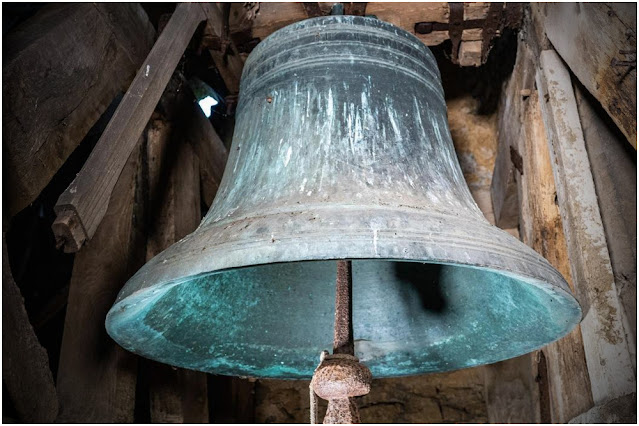Bells
If you have ever cycled or driven along the A16 towards Grimsby, you could easily be forgiven for failing to notice the adjacent settlements of Grainsby and Waithe. These two parishes are tiny, and the single villages within that share their names, are both just a mere few houses strung along a single lane road.
Once much larger communities, with manor houses, domestic properties, and outlying farms and even a mill in Waithe, they are now much reduced, populations in both parishes having peaked around the 1880s. One thing that has not changed however in each case, is the Parish church. Standing near the centre as they have done since the early middle ages, quietly serving the spiritual needs of the residents. The churches of Gainsby and Waithe are not the large tall-spired structures seen elsewhere around the County, instead being much smaller, humbler buildings, both hidden from roadside view by curtains of tall trees.
 |
| St Martin's Church, Waithe, the central tower dates back to the 11th Century. |
And there is an interesting local legend about these churches, or more to say about a particular item common to both churches. That is, at some point their church bells were swapped!
Few church buildings are lucky enough to have survived into the modern age, looking EXACTLY as their original architect intended. Along with upkeep and maintenance, the appearance of churches often ebbs and flows with the fashions of the period. A nave may be heightened to accommodate new larger windows, auxiliary altars and side chapels come about through the largess of the local Lord of the manor who may pay for works to improve their place of worship.
The tower that holds the belfry may be heightened or possibly work might need to be undertaken to reinforce or repair the timbers that support the peal of bells that call the faithful to worship.
 |
| St. Nicholas' Church, Grainsby, with its chalk tower and odd belfry window! |
Whatever the case was here, it appears at one point in their history, both the church of St Martin's at Waithe, and St Nicholas at Grainsby required work on their respective towers at the same time. Possibly the work took longer than expected, maybe being neighbouring parishes, there was a degree of cooperation? This might explain the bells from both churches being stored in the one location
Writing in The Church Bells of of the County and City of Lincoln, Thomas North says of Grainsby
" There is a tradition that the Bells now at Waith once hung in this church, and that during some repairs going on in both churches, and with the bells, at the same time, the latter were changed over "
An honest mix up by the builders? Or did envious residents maybe consider the bells of the neighbours church rang sweeter than their own? We will likely never know. When I visited the area I unfortunately couldn't get access to St Martin's at Waithe, the door being locked and no sign of where to find a key holder. However, I was lucky enough to find St Nicholas' at Grainsby open. It is a small low church, built of a curious mixture of the local Spilsby Greenstone, and a tower comprised almost entirely of white chalk blocks topped with a stone battlemented parapet. Halfway up this tower is one of the most unusual belfry openings I have ever seen, an oval (known in the historical building world as a vesica) divided in two by a simple stone mullion. Looking like an eye set sideways. Inside it was all peace and silence, with sunlight dappled by the trees around the churchyard casting spotted patterns on the stone floor.
The tower and bell ringers floor were separated from the nave by a red curtain, and peeking my head through I was surprised to see a ladder reaching high up to a trapdoor in the tower ceiling. For a moment I was very tempted to climb up and see if I could lay eyes on the mixed up bells of Waithe, but dire warnings about unsafe woodwork, were enough to temper my curiosity and I had to do with some photos looking towards the inviting darkness above.
 |
| Inside the tower at St. Nicholas'. Does this ladder lead to the bells of Waithe? |
But the oddest thing, is this isn't the only region in Lincolnshire to hold onto this bit of folklore about mixed up bells!
Thomas North, also writes that the communities of Baston and Langtoft were both improving their churches around the same time, and both had ordered bells to be cast for their towers. And somehow the founder became confused, and as a result mis-sent the Baston bells to Langtoft, and the Langtoft bells to Baston, where they were dutifully hung in the wrong belfries!
The casting of bells involved commissioning the services of an experienced master bellfounder, and required large quantities of expensive materials. The composition of bell-metal is consistently recorded as to be 1 part tin to 3 parts copper. Superstition has it that the addition of some silver to this mixture will improve the tone of the finished bell. However true or not this proved to be, it became customary to at least cast a few coins into the furnace each time a new bell was cast. Given the costs involved it's hardly surprising that there are local legends of some communities taking to less honest methods of acquiring a bell for their church. Again Thomas North writes:
" There is a tradition current at Appleby (A village in North Lincolnshire) that the people there stole the tenor Bell now hanging in their church from their neighbours at Broughton "
However upon subsequent study, Tomas was able to confirm
" There was however clearly no loss of a bell between 1553 and 1867; So the character of the Appleby folk for honesty need no longer be impunged! "
In fact this very value of a church's bells meant that some poor communities when faced with a sudden and unavoidable need to undertake expensive repairs to their church had to do the unthinkable and sell their own set. This was a behaviour that often brought mocking and scorn from neighbouring parishes, as can be seen in this limerick about Owersby, West Lindsey.
Literary Byways, p.104;
And before we finish we must return to Grainsby, where locals (as happens with lots of peals of bells across the country) noted that the sounds of their bells and that of nearby North Thorseby would appear to be asking each each other
" Who sounds the best? Who sounds the best? "
At which point the bells of St Michael's, Hawerby further South would chime in a cheeky reply.
" We do! We do! "
----------------------------
Sources and further info:



Comments
Post a Comment